Samaritan woman at the well
The Samaritan woman at the well is a figure from the Gospel of John, in John 4:4–26. In Eastern Orthodox and Eastern Catholic traditions, she is venerated as a saint with the name Photine (Φωτεινή also Photini, Photina, meaning "the luminous one" from φῶς, "light").
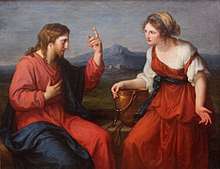
Biblical account

The woman appears in John 4:4–42, However below is John 4:4–26:
But he had to go through Samaria. So he came to a Samaritan city called Sychar, near the plot of ground that Jacob had given to his son Joseph. Jacob's well was there, and Jesus, tired out by his journey, was sitting by the well. It was about noon.
A Samaritan woman came to draw water, and Jesus said to her, "Give me a drink." (His disciples had gone to the city to buy food.) The Samaritan woman said to him, "How is it that you, a Jew, ask a drink of me, a woman of Samaria?" (Jews do not share things in common with Samaritans.) Jesus answered her, "If you knew the gift of God, and who it is that is saying to you, 'Give me a drink', you would have asked him, and he would have given you living water." The woman said to him, "Sir, you have no bucket, and the well is deep. Where do you get that living water? Are you greater than our ancestor Jacob, who gave us the well, and with his sons and his flocks drank from it?" Jesus said to her, "Everyone who drinks of this water will be thirsty again, but those who drink of the water that I will give them will never be thirsty. The water that I will give will become in them a spring of water gushing up to eternal life." The woman said to him, "Sir, give me this water, so that I may never be thirsty or have to keep coming here to draw water."
Jesus said to her, "Go, call your husband, and come back." The woman answered him, "I have no husband." Jesus said to her, "You are right in saying, 'I have no husband'; for you have had five husbands, and the man you are now living with is not your husband. What you have said is true!" The woman said to him, "Sir, I see that you are a prophet. Our ancestors worshipped on this mountain, but you say that the place where people must worship is in Jerusalem." Jesus said to her, "Woman, believe me, the hour is coming when you will worship the Father neither on this mountain nor in Jerusalem. You worship what you do not know; we worship what we know, for salvation is from the Jews. But the hour is coming, and is now here, when the true worshippers will worship the Father in spirit and truth, for the Father seeks such as these to worship him. God is spirit, and those who worship him must worship in spirit and truth." The woman said to him, "I know that Messiah is coming" (who is called Christ). "When he comes, he will proclaim all things to us." Jesus said to her, "I am he, the one who is speaking to you."
This episode takes place before the return of Jesus to Galilee.[1] Some Jews regarded the Samaritans as foreigners and their attitude was often hostile, although they shared most beliefs, while many other Jews accepted Samaritans as either fellow Jews or as Samaritan Israelites.[2][3][4] The two communities seem to have drifted apart in the post-exilic period.[5] Both communities share the Pentateuch, although crucially the Samaritan Pentateuch locates the holy mountain at Mount Gerizim rather than at Mount Zion, as this incident acknowledges at John 4:20.
The Gospel of John, like the Gospel of Luke, is favourable to the Samaritans throughout, and, while the Matthaean Gospel quotes Jesus at one early phase in his ministry telling his followers to not at that time evangelize any of the cities of the Samaritans,[6] this restriction had clearly been reversed later by the time of Matthew 28:19. Scholars differ as to whether the Samaritan references in the New Testament are historical. One view is that the historical Jesus had no contact with Samaritans; another is that the accounts go back to Jesus himself. In Acts 1:8, Jesus promises the apostles that they will be witnesses to the Samaritans.[7]
Interpretations
Scholars have noted that this story appears to be modelled on a standard betrothal 'type scene' from Hebrew scripture, particularly that of Jacob in Genesis 29.[8] This convention, which would have been familiar to Jewish readers, following on from an earlier scene in which John the Baptist compares his relationship to Jesus with that of the friend of a bridegroom.[1] Jo-Ann A. Brant, for example, concludes that there is "near consensus among literary critics that the scene at Jacob’s well follows conventions of the betrothal type-scene found in Hebrew narrative."[9] Other scholars note significant differences between John 4 and betrothal type-scenes in the Hebrew Bible.[10][11] For example, Dorothy A. Lee lists several discrepancies between Hebrew betrothal scenes and John 4: “the Samaritan woman is not a young Jewish virgin and no betrothal takes place; the well is not concerned with sexual fertility but is an image of salvation (see Isa. 12:3); Jesus is presented not as a bridegroom but as giver of living water.”[12]
This Gospel episode is referred to as "a paradigm for our engagement with truth", in the Roman Curia book A Christian reflection on the New Age, as the dialogue says: "You worship what you do not know; we worship what we know" and offers an example of "Jesus Christ the bearer of the water of life".[13] The passages that comprise John 4:10–26 are sometimes referred to as the Water of Life Discourse, which forms a complement to the Bread of Life Discourse.[14]
In Eastern Christian tradition, the woman's name at the time of her meeting Jesus is unknown, though she was later baptized "Photini". She is celebrated as a saint of renown. As further recounted in John 4:28–30 and John 4:39–42, she was quick to spread the news of her meeting with Jesus, and through this many came to believe in him. Her continuing witness is said to have brought so many to the Christian faith that she is described as "equal to the apostles". Eventually, having drawn the attention of Emperor Nero, she was brought before him to answer for her faith, suffering many tortures and dying a martyr after being thrown down a dry well. She is remembered on the Sunday four weeks after Pascha, which is known as "the Sunday of the Samaritan Woman".
In Oaxaca, Oaxaca, Mexico, a celebration of the Samaritan woman takes place on the fourth Friday of Lent. The custom of the day involves churches, schools, and businesses giving away fruit drinks to passers-by.[15]
Cultural references
In visual art
- Jesus and the Samaritan Woman at the Well
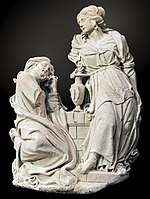 Samaritan woman at the well 1651 by Gervais Drouet
Samaritan woman at the well 1651 by Gervais Drouet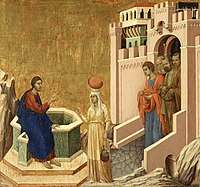 Christ and the Samaritan Woman, by Duccio di Buoninsegna
Christ and the Samaritan Woman, by Duccio di Buoninsegna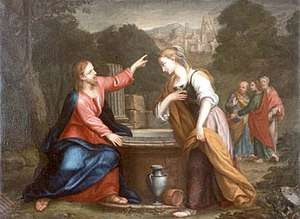 Jesus and the Samaritan Woman at the Well, by Giacomo Franceschini
Jesus and the Samaritan Woman at the Well, by Giacomo Franceschini Christ and the Samaritan Woman, by Stefano Erardi
Christ and the Samaritan Woman, by Stefano Erardi Christ and the Samaritan Woman, by Jan Joest van Kalkar
Christ and the Samaritan Woman, by Jan Joest van Kalkar Jesus and the Samaritan Woman at the Well, by Guercino
Jesus and the Samaritan Woman at the Well, by Guercino Christ and the Samaritan Woman, by Josef von Hempel
Christ and the Samaritan Woman, by Josef von Hempel.jpg) Christ and the Samaritan Woman, by Lucas Cranach the Elder
Christ and the Samaritan Woman, by Lucas Cranach the Elder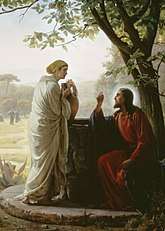 Woman at the Well by Carl Heinrich Bloch
Woman at the Well by Carl Heinrich Bloch
In music
- "Jesus Met the Woman at the Well", a gospel song dating from 1949 or before (earliest known recording by The Fairfield Four)
- "Lift Him Up That's All", a gospel song dating from 1927 or before (earliest known recording by Washington Phillips)
- The Woman of Samaria, a sacred cantata of 1867 by the English classical composer William Sterndale Bennett
- "Fill My Cup Lord", a hymn written by Richard Blanchard in 1959.[16]
- “Jesus Gave Me Water”, a gospel song by The Soul Stirrers in 1951.
See also
References
Citations
- Lincoln 2005, p. 170-171.
- Samkutty 2006, p. 81.
- Crown, Davey & Sixdenier 1995, p. 134.
- Bourgel 2018.
- Ferguson 2003, p. 534.
- Samkutty 2006, p. 85.
- Samkutty 2006, pp. 100–101.
- Quast 1991, p. 29.
- Brant 1996.
- Okure 1988, pp. 88-89.
- Resseguie 2001, p. 76, n. 45.
- Lee 1994, p. 67, n. 3.
- Pontifical Council for Culture; Pontifical Council for Interreligious Dialogue (2 March 2003). Jesus Christ the Bearer of the Water of Life: A Christian reflection on the "New Age". Vatican City: Internet Office of the Holy See.
- Barrett 1978, p. 12.
- "La Samaritana 2011 en Oaxaca" (in Spanish). Vive Oaxaca. Retrieved 3 June 2013.
- "Hymn: Fill My Cup, Lord". www.hymnal.net. Retrieved Mar 20, 2020.
Sources
- Barrett, C. K. (1978). The Gospel According to St. John: An Introduction with Commentary and Notes on the Greek Text (2nd ed.). Westminster John Knox Press. ISBN 978-0-664-22180-5.CS1 maint: ref=harv (link)
- Bourgel, Jonathan (2018). "John 4:4–42: Defining A Modus Vivendi Between Jews And The Samaritans". The Journal of Theological Studies. 69 (1): 39–65. doi:10.1093/jts/flx215. ISSN 0022-5185.CS1 maint: ref=harv (link)
- Brant, Jo-Ann A. (1996). "Husband Hunting: Characterization and Narrative Art in the Gospel of John". Biblical Interpretation. 4 (2): 205–223. doi:10.1163/156851596X00194. ISSN 0927-2569.
- Crown, Alan David; Davey, Lucy; Sixdenier, Guy Dominique, eds. (1995), "Essays in honour of GD Sexdenier: New Samaritan studies of the Société d'études samaritaines", Studies in Judaica 5, Sydney: Mandelbaum / University of SydneyCS1 maint: ref=harv (link)
- Ferguson, Everett (2003). Backgrounds of Early Christianity. Wm. B. Eerdmans. ISBN 978-0-8028-2221-5.CS1 maint: ref=harv (link)
- Lee, Dorothy A. (1994). The Symbolic Narratives of the Fourth Gospel: The Interplay of Form and Meaning. Sheffield: Sheffield Academic Press. ISBN 978-1-85075-468-8.CS1 maint: ref=harv (link)
- Lincoln, Andrew T. (2005). The Gospel According to Saint John. Hendrickson Publishers. ISBN 978-1-56563-401-5. OCLC 61129929.CS1 maint: ref=harv (link)
- Okure, Teresa (1988). The Johannine approach to mission: a contextual study of John 4:1-42. Tübingen: J. C. B. Mohr. ISBN 978-3-16-145049-5.CS1 maint: ref=harv (link)
- Quast, Kevin (1991). Reading the Gospel of John: An Introduction. Paulist Press. ISBN 978-0-8091-3297-3.CS1 maint: ref=harv (link)
- Resseguie, James L. (2001). The Strange Gospel: Narrative Design and Point of View in John. Leiden: Brill. ISBN 90-04-12206-0.CS1 maint: ref=harv (link)
- Samkutty, V. J. (2006). The Samaritan Mission in Acts. A&C Black. ISBN 978-0-567-04464-8.CS1 maint: ref=harv (link)
External links
- Photine of Samaria at orthodoxwiki.org
